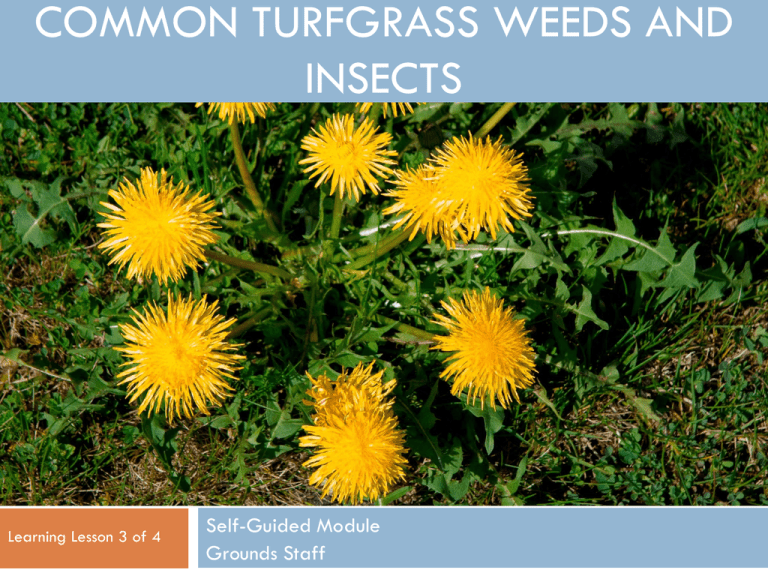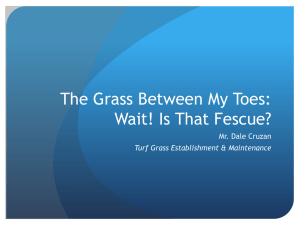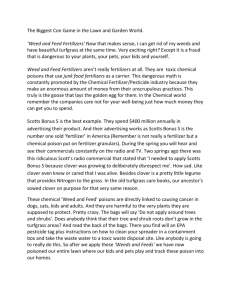COMMON TURFGRASS WEEDS AND INSECTS Self-Guided Module Grounds Staff
advertisement

COMMON TURFGRASS WEEDS AND INSECTS Learning Lesson 3 of 4 Self-Guided Module Grounds Staff Learning Objectives 2 1. 2. 3. 4. Identify plant species suited for site-specific environmental qualities, pest pressure and use. Identify and describe how to manage common turfgrass weeds. Identify and describe how to manage common turfgrass insect pests. Identify and describe how to manage common turfgrass vertebrate pests. IPM for Lawn and Turfgrass 3 IPM for lawns and turf is a long-term approach to maintaining healthy and reduced risk outdoor areas. This approach includes: Site assessment Monitoring Prevention Management Evaluation of practices Components of an IPM Program on School Grounds 4 Promoting turfgrass health: Select grass species that will thrive on the site and support the site use. Prepare the site properly. Provide proper cultural care. It is critical to consider the use of the turf when selecting turfgrass species and cultivars. Selecting Turfgrass 5 1. 2. 3. 4. Select a turfgrass seed mix that will thrive in the area. Grasses with disease resistance are generally only resistant to one disease and may be susceptible to other turfgrass diseases. Certain grasses containing endophytes can prevent outbreaks of above-ground insect pests. Select grass types that can tolerate the level of play or traffic on the area. Turfgrass Identification 6 Seedhead Blade Sheath Ligule Auricles Node Midrib Stolon Tiller Collar Bud Leaf Crown Rhizome Roots comprise almost half of the entire grass plant Turfgrass Selection 9 Kentucky Bluegrass Perennial Ryegrasses Tall Fescue Fine Fescue Growth habit Rhizomatous Bunch Bunch Bunch, some rhizomes Leaf texture (blade width) Medium-Fine Medium Course Very Fine Establishment from seed Slow Fast Medium-Fast Medium Seeding rate 1 to 2 lb./1,000 5 to 9 lb./1,000 5 to 9 lb./1,000 3 to 5 lb./1,000 ft.2 ft.2 ft.2 ft.2 Annual nitrogen fertilizer 3 to 4 lb./1,000 2 to 4 lb./1,000 2 to 4 lb./1,000 1 to 2 lb./1,000 ft.2 ft.2 ft.2 ft.2 Drought tolerance Poor Poor Some Some Shade tolerance Poor (min. 4 hours direct sun) Poor Good Excellent Wear tolerance (traffic) Good Good Poor Good 8 Examples of Turfgrass Species – North Central 9 Turfgrass Characteristics Grass species Kentucky bluegrass Growth habit Rhizomes Leaf texture /color Fine to medium Dark green Supina bluegrass Stolons Fine to medium Light green Perennial ryegrass Bunch Fine to medium Tall fescue Bunch Medium to coarse Fine fescue Bunch, some rhizomes Medium to fine Preferred environment Well drained, sunny areas. High nutrient and water requirements. Tolerance attributes Cold - high Wear - high Drought - low Shade - low Cold - high Sun to dense shade. Heat - low High nutrient and water Drought - low requirements. Wear - very high Cold - low Well drained soils. Moderate fertility and water Heat - low Drought - moderate requirement. Shade - low Wear - high Cold - low Well drained soils. Heat - high Open sunny areas. Low Drought -high fertility requirement. Shade - moderate Wear - moderate Cold - high Cool, dry, well drained, shade tolerant, well drained Heat/salt - low Drought - moderate Wear - moderate Shade - moderate Examples of Turfgrass Species – Northeastern 10 Turfgrass Characteristics Grass species Kentucky bluegrass Growth habit Rhizomes Leaf texture Medium to fine Preferred environment Sunny, well drained Tolerance attributes Cold - high Heat - moderate Drought - moderate Wear – moderate Shade - low Cool, dry, well drained, shade Cold - high Heat/salt - low tolerant, well drained Drought - moderate Wear - moderate Shade - high Fine fescue Bunch, some rhizomes Medium to fine Perennial ryegrass Bunch Medium to fine Well drained, moderate fertility Tall fescue Bunch Medium to coarse Sun and shade Cold - low/moderate Heat /moderate/high Wear - high Drought - low Shade - low Cold - low/moderate Heat - high Drought - moderate Wear - high Shade - moderate Salinity - moderate Examples of Turfgrass Species – Western 11 Turfgrass Characteristics Grass species Kentucky bluegrass Growth habit Rhizomes Leaf texture Medium to fine Preferred environment Sunny, well drained High elevation Supina bluegrass Stolons Fine to medium Light green Sun to dense shade. High nutrient requirements. Bermudagrass (southwestern) Rhizomes & stolons Fine, medium to coarse Sunny, tolerates most soil conditions. High fertility requirement. Low – medium elevation Perennial ryegrass Bunch Medium to fine Well drained, moderate fertility Tall fescue Bunch Medium to coarse Sun and shade Tolerance attributes Cold - high Heat - moderate Drought - moderate Wear - moderate Cold - high Heat - low Drought - low Wear - very high Cold - moderate Heat/salt - high Drought - high Wear - high Cold - low/moderate Heat /moderate/high Drought - low Wear - high Shade – low Cold - low/moderate Heat - high Drought -moderate Wear - moderate Shade - moderate Salinity - moderate Examples of Turfgrass Species – Pacific Northwest 12 Turfgrass Characteristics Grass species Growth habit Leaf texture Kentucky bluegrass Rhizomes Medium to fine Fine fescue Bunch, some rhizomes Perennial ryegrass Bunch Tall fescue Bunch Preferred environment Tolerance attributes Cold - high Heat - moderate Drought - moderate Wear - moderate Cold - high Medium to fine Cool, dry, well Heat/salt - low drained, shade tolerant, well drained Drought - moderate Wear - moderate Shade - high Cold - low/moderate Medium to fine Well drained, Heat /moderate/high moderate fertility, Wear - high sunny Drought - low Shade - low Cold - low/moderate Medium to coarse Sun and shade Heat - high Drought - moderate Wear - moderate Shade - moderate Salinity - moderate Sunny, well Drained. Recovery – slow in late fall. Examples of Turfgrass Species – Southern 13 Turfgrass Characteristics Grass species Bermudagrass Growth habit Rhizomes & stolons Leaf texture Fine, medium to coarse Zoysiagrass Rhizomes & stolons Fine, medium to coarse Centipede Rhizomes & stolons Medium to coarse Tall fescue Bunch Medium to coarse Fine fescue Bunch, some rhizomes Medium to fine Tolerance attributes Cold - moderate Heat/salt - high Drought - high Wear - high Cold - good Sun to moderate Heat/salt - high Shade. Recovery is slow. Drought - high Wear - high Cold - fair Sunny, tolerates low pH Heat - good conditions.. Salinity - poor Wear - poor/moderate Cold - low/moderate Sun and shade Heat - high Drought - moderate Wear - high Shade - moderate Salinity - moderate Cool, dry, well drained, shade Cold - high Heat/salt - low tolerant, well drained Drought - moderate Wear - moderate Shade - high Preferred environment Sunny, tolerates most soil conditions Managing Turf Weeds 14 Keep turfgrass healthy to out-compete weeds. Use certified seed for overseeding. These have fewer weed seeds than low-quality seed mixes. Soil pH can be a huge factor in weed invasion and turf decline. Avoid fertilizer applications when common annual weed seeds may be germinating. Establish weed population thresholds by management zone. Low visibility, low maintenance zones can tolerate more weeds. Weed Monitoring: The Transect Method 15 □ □ □ Randomly choose a series of representative transects for sampling. Walk each transect, stop at 20 or more evenly spaced sampling units (steps or measures) and record the presence/absence of weeds in a 3x3 foot area in front. Estimate the percentage of area covered by weeds in each 3x3' sample and calculate the average over all 20 samples. Samples Covered by weeds 10 40% (10x40%) = 400% 400% + 100% = 500% 10 10% (10x10%) = 100% 500%/20 sites = 25% □ Monitor regularly, recognize trends and develop thresholds for action based on management zones. Common Turfgrass Weeds: Northeast 16 Weeds Velvetleaf Common ragweed Common lambsquarters Hairy galinsoga Eastern black nightshade Common chickweed Giant foxtail Yellow foxtail Large crabgrass Yellow nutsedge Common Chickweed John D. Byrd, Mississippi State University, bugwood.org Common Turfgrass Weeds: Midwest 17 Weeds Bull thistle Canada thistle Carolina geranium Chicory Common purslane Curly dock Large crabgrass Mouseear chickweed Common mallow Perennial sowthistle Bull thistle Eric Coombs, Oregon Department of Agriculture, bugwood.org Common Turfgrass Weeds: Pacific Northwest 18 Weeds Annual bluegrass Buttercup Chickweed Clover Crabgrass White clover Moss Plantain Thistles Red sorrel White clover Dr. Tim Miller, WSU Weed Specialist Common Turfgrass Weeds: South 19 Weeds Dallisgrass Bahiagrass Annual bluegrass Spurge Chickweed Crabgrass Dandelion Common chickweed Ohio State Weed Lab Archive, The Ohio State University Identify, Monitor, Manage Turfgrass Weeds 20 Annual Weed Species Summer annual weeds germinate in spring, grow to maturity during summer and die by fall or winter. If herbicides are needed to control summer annuals, apply pre-emergent herbicides in the spring to prevent germination. Winter annual weeds germinate in the fall and winter, grow actively in spring and die by summer. If herbicides are needed to control winter annuals, apply pre-emergent herbicides in the early fall to prevent germination. Identify, Monitor, Manage Turfgrass Weeds 21 Biennial weeds: Grow during the spring, summer and fall of their first year, survive the following winter, and then produce seed in the second growing season. Perennial weeds: Live more than two years and spread by seeds and vegetative means such as bulbs, rhizomes, tubers or nutlets. If herbicides are needed for perennial or biennial weeds, use fall applications of selective broadleaf herbicides. Site Selection and Preparation 22 It is especially important to get difficult perennial weeds under control before planting. Trying to grow turfgrasses on poor sites may take additional work. Irrigate the site before planting to allow weed seeds on site to germinate before grass seed is planted. Sites with limited water, less than four to six hours of direct sunlight, and/or minimal nutrients may be poor sites for growing turfgrass, but many weed species can survive in these conditions. Identifying and Monitoring Turfgrass Insects 23 Insect pests can vary by region and are important indicators of turfgrass health. Monitor and record data on pests that may need to be managed in your region and at your site. Masked chafers (white grubs) UC IPM, http://www.ipm.ucdavis.edu Common Turfgrass Pests: Northeast 24 Insects Beetle grubs Sod webworms Chinch bugs Billbugs Cutworms Army cutworm Frank Peairs, Colorado State University, Bugwood.org Common Turfgrass Pests: Intermountain West 25 Insects Billbugs Chinch bug Banks grass mite Leafhoppers Beet leafhopper G. Oldfield, USDA, Bugwood.org Common Turfgrass Pests: Midwest 26 Insects White grubs Billbugs Sod webworm Aphids Crickets Field Cricket Joseph Berger, Bugwood.org Common Turfgrass Pests: Pacific Northwest 27 Insects European cranefly White grubs Chinch bug Billbugs European cranefly Common Turfgrass Pests: Gulf Coast 28 Insects Armyworms Red imported fire ants Grasshoppers Mole crickets Southern chinch bugs Tropical sod webworm White grubs Grasshopper R.J. Reynolds, R.J. Reynolds Tobacco Company, Bugwood.org Common Turfgrass Pests: South 29 Insects Fire ants Chinch bugs Spittlebugs Sugarcane beetles Henbit Spurges Twolined spittlebug Clemson University - USDA Cooperative Extension Slide Series, Bugwood.org Managing Turfgrass Insect Pests 30 Healthy turf rarely requires insecticide treatment for insect pests. Insect pest problems are often limited to small areas of turf that have cultural issues that need correcting such as improper pH, low fertility, poor drainage and turf root growth, overwatering or improper mowing. The right question to ask is, why is this pest here? Not which pesticide should I use? Managing Turfgrass Insect Pests 31 In regions affected by grubs, avoid planting roses, grapes or oaks to avoid attracting beetles, the adult stage of grub species. Grub-infested turf suffers root loss; heavily infested turf may need light and frequent irrigations to survive the summer heat. Avoid excessive night lighting which can attract beetles that will lay eggs in turf. Managing Turfgrass Insect Pests 32 Dethatching reduces chinch bug activity for up to two years where sod-forming lawn grasses have been planted. Consider grass cultivars that contain “endophytes” for areas with chronic chinch bug, billbug, cutworm or sod webworm problems. Endophytes can effectively control other above ground-feeding insects as well. If insecticides are needed to control insects, irrigate and remove thatch first to draw grubs into the upper root zone. Treat affected spots only. Chinch Bugs 33 Chinch bugs reach peak populations during high heat. Dry turf is particularly susceptible to this insect because of the added environmental stress. Particularly susceptible turf includes: Kentucky bluegrass Perennial and annual ryegrass Tall and fine fescue St. Augustine grass Chinch bugs feed on grass blades and can cause damage at high densities. White Grubs 34 Turf damage can peak in late summer as grubs increase in size and feeding capacity. Managing Grubs 35 Use a shovel to determine the number of grubs per square foot before initiating any treatment. Ask your Extension agent for action thresholds levels. White Grubs 36 White grubs are typically one of the following species: Japanese beetle June beetle European chafer Asian garden beetle Oriental beetle Japanese Beetle, white grub Asiatic garden beetle John A. Weidhass, Virginia Polytechnic Institute and State University, Northern masked chafer Bugwood.org Black turfgrass ataenius beetle Billbug 37 Billbug larvae tunnel through plants while feeding on the stem. Damage frequently appears from late June through early August. Signs of damage include spotty, strawcolored patches of grass scattered throughout the lawn. Billbug David Shetlar, The Ohio State University, Bugwood.org Identifying Turfgrass Vertebrates 38 Pocket gophers Prairie dogs Meadow voles Moles Rabbits and hares Ground squirrels Deer Collared peccary (javelina) Monitoring and Managing Turfgrass Vertebrate Pests 39 Vertebrate pests can harm turfgrass when they dig to look for pests to eat. By controlling the insect pest population, you will in turn, deter vertebrate pests from visiting. Monitor for signs of vertebrate activity as this may be a sign that you have a pest infestation. Check In! 40 This lesson you learned: 1. How to identify plant species suited for a site’s environmental qualities, pest pressures and use. 2. How to identify and describe how to manage common turfgrass weeds. 3. How to identify and describe how to manage common turfgrass insect pests. 4. How to identify and describe how to manage common turfgrass vertebrate pests. Next you will learn about common turfgrass diseases! Turfgrass Resources 41 State by state guidelines and turf selection, click here. The links below will be placed on a website, please send us your go-to site and we will list it on the site Resources 42 Insect Images. (2010). Lawn and Turf. Retrieved from http://www.bugwood.org/ Iowa State University. (2010). Plant and Insect Diagnostic Clinic. Retrieved from http://www.ipm.iastate.edu/ipm/info/plant-diseases/turf-grass-rust Maine Department of Agriculture, Conservation and Forestry. School IPM. Retrieved from http://www.maine.gov/dacf/php/integrated_pest_management/school/index.shtml Rutgers Cooperative Extension. IPM Report Card for School Grounds: General Requirements. Retrieved from http://entomology.osu.edu/schoolipm/IPMfiles/ReportCardGeneral.pdf Texas A&M Agrilife Extension. Landscape IPM Module 6. Retrieved from http://schoolipm.tamu.edu/videodvd/ Umass Extension Center for Agriculture. Best Management Practices For Lawn and Landscape Turf. Retrieved from http://extension.umass.edu/turf/sites/turf/files/pdf-docppt/lawn_landscape_BMP_2013_opt.pdf University of California Agricultural and Natural Resources. (2009). How to Manage Pests. Retrieved from http://www.ipm.ucdavis.edu/PMG/r785100411.html

